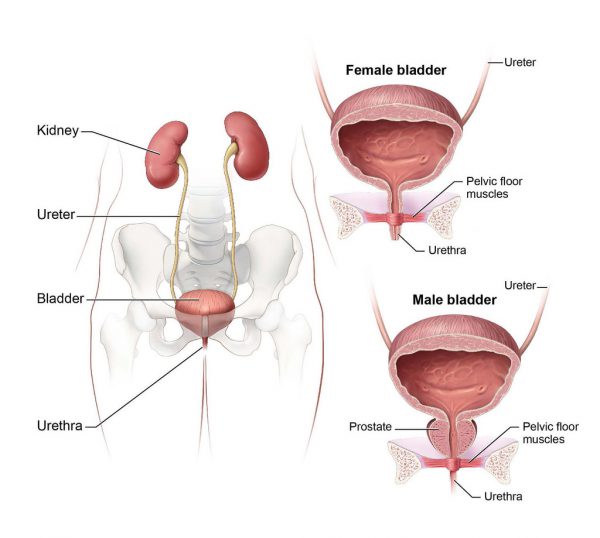 Loss of urinary bladder control is called urinary incontinence. It means you can’t always control when you pass urine. As a result you wet your clothes. It can happen to anyone at any age but is very common in older people. At least one in ten people aged 65 years or older has this problem. In India, about 50 million people suffer from some type of urinary incontinence. It is twice more common in females as compared to males. But ageing can decrease bladder capacity, decrease urinary steam and increase frequency of urination. Urinary incontinence may be transient or permanent. Its severity can vary from leakage on sneezing and laughing to leakage due to urgency or continuous leakage.
Loss of urinary bladder control is called urinary incontinence. It means you can’t always control when you pass urine. As a result you wet your clothes. It can happen to anyone at any age but is very common in older people. At least one in ten people aged 65 years or older has this problem. In India, about 50 million people suffer from some type of urinary incontinence. It is twice more common in females as compared to males. But ageing can decrease bladder capacity, decrease urinary steam and increase frequency of urination. Urinary incontinence may be transient or permanent. Its severity can vary from leakage on sneezing and laughing to leakage due to urgency or continuous leakage.
People with urinary incontinence are frequently depressed and regressed. They often curtail all social activities and stay at home. If you are having bladder control problems and are reluctant to talk to your doctor about it, then know that there is help available and nearly all types of urinary incontinence can be treated and often cured at all ages.
Normally body stores urine in the urinary bladder. During urination, muscle in bladder contract or tighten. This forces urine out of the urinary bladder and into a tube called urethra, which then carries urine out of the body. Incontinence occurs if bladder muscles contract or muscles surrounding urethra relax without warning. There are different types of urinary incontinence like stress urinary incontinence which urine leakage occurs because of sudden increase in intra abdominal pressure, e.g. during coughing, laughing and sneezing. weight lifting or exercise. Urge urinary incontinence occurs when need to urinate comes on too fast before you can go to the toilet; overflow urinary incontinence occurs as a constant dribbling of urine due to overfilled bladder because of obstruction or blockage to urinary flow as in prostatic enlargement or urethral stricture; functional urinary incontinence occurs when there is lack of mobility to reach the bathroom,e.g. In severe arthritis or bed-ridden persons. Often the urinary incontinence is a of mixed type in which more than one type of urinary incontinence is present. Common cause of urinary incontinence are over-activity of bladder, post-menopausal state in females, prostatic operation in males, weakness of pelvic muscles, constipation, immobility, drugs, urinary infection and diabetes.
Treatment for Urinary Incontinence
Treatment for urinary incontinence depends on the type of incontinence, its severity and the underlying cause. A combination of treatments may be needed . The patient is offered the least invasive treatments first and offered other options only if these techniques fail.
 Behavioural techniques include bladder training, double voiding, scheduled toiled trips and fluid and diet management. These are tailored according to the type of incontinence. Pelvic floor muscle exercises, popularly known as Kegels exercises are recommended to strengthen the muscle that help control urination. These techniques are especially effected for stress incontinence but may also help urge incontinence. To help you identify and contract the right, we may recommend working with a physical therapist or try biofeedback techniques. In electrical stimulation, electrodes are temporarily inserted into the rectum or vagina to stimulate and strengthen pelvic Floor muscles. Medicines are are commonly used to treat incontinence and vary with the type of incontinence. Medical devices designed to treat women with incontinence include urethral inserts and vaginal pessaries, absorbent pads.
Behavioural techniques include bladder training, double voiding, scheduled toiled trips and fluid and diet management. These are tailored according to the type of incontinence. Pelvic floor muscle exercises, popularly known as Kegels exercises are recommended to strengthen the muscle that help control urination. These techniques are especially effected for stress incontinence but may also help urge incontinence. To help you identify and contract the right, we may recommend working with a physical therapist or try biofeedback techniques. In electrical stimulation, electrodes are temporarily inserted into the rectum or vagina to stimulate and strengthen pelvic Floor muscles. Medicines are are commonly used to treat incontinence and vary with the type of incontinence. Medical devices designed to treat women with incontinence include urethral inserts and vaginal pessaries, absorbent pads.
Interventional Therapies: Interventional therapies that may help with incontinence include injections of botulinum toxin type A (Botox) into the bladder muscle. This may benefit people who have an overactive bladder. Another option is the use of nerve stimulators.
Surgery:If other treatment aren’t working, several surgical procedures can treating problems that cause urinary incontinence. These include:
Sling Procedures: Strips of body’s tissue, synthetic material or mesh are used to create a pelvic sling around the urethra. The sling helps keep the urethra closed, especially when the patient cough or sneezes. This procedure is used to treat stress incontinence.
Bladder neck suspension procedures
Prolapse Surgery: In women with mixed incontinence and pelvic organ prolapse, surgery may include a combination of a sling procedure and prolapse surgery.
In view of such variety of treatment options available today, persons suffering from urinary incontinence can look forward to having a normal life once again. They only need to overcome their inhibitions and understand that their problems of urinary incontinence can be corrected if they contact a qualified urologist and discuss their problems.


